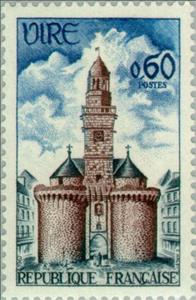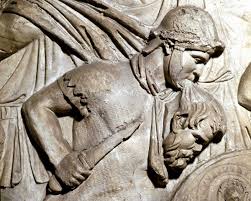Stamp: Vire. The Gate and Clock Tower (France 1967)
Vire. The Gate and Clock Tower (France 1967)
10 July (France ) within release Tourism goes into circulation Stamp Vire. The Gate and Clock Tower face value 0.60 French franc
| Stamp Vire. The Gate and Clock Tower in catalogues | |
|---|---|
| Yvert et Tellier: | Yt:FR 1500 |
| Michel: | Mi:FR 1592 |
Stamp is vertical format.
variety: (a) missing French Republic and buildings (b) French Republic in white lettersStamp Vire. The Gate and Clock Tower it reflects the thematic directions:
Gates is the plural of gate, a point of entry to a space which is enclosed by walls.
Tourism is travel for pleasure or business; also the theory and practice of touring, the business of attracting, accommodating, and entertaining tourists, and the business of operating tours. Tourism may be international, or within the traveller's country. The World Tourism Organization defines tourism more generally, in terms which go "beyond the common perception of tourism as being limited to holiday activity only", as people "traveling to and staying in places outside their usual environment for not more than one consecutive year for leisure, business and other purposes". Tourism can be domestic or international, and international tourism has both incoming and outgoing implications on a country's balance of payments. Today, tourism is a major source of income for many countries, and affects the economy of both the source and host countries, in some cases being of vital importance.
A tower is a tall structure, taller than it is wide, often by a significant factor. Towers are distinguished from masts by their lack of guy-wires and are therefore, along with tall buildings, self-supporting structures.
The Goths (Gothic: 𐌲𐌿𐍄𐌸𐌹𐌿𐌳𐌰, romanized: Gutþiuda; Latin: Gothi, Greek: Γότθοι, translit. Gótthoi) were Germanic people who played a major role in the fall of the Western Roman Empire and the emergence of medieval Europe
A building or edifice is a structure with a roof and walls standing more or less permanently in one place, such as a house or factory. Buildings come in a variety of sizes, shapes and functions, and have been adapted throughout history for a wide number of factors, from building materials available, to weather conditions, to land prices, ground conditions, specific uses and aesthetic reasons. Buildings serve several needs of society – primarily as shelter from weather, security, living space, privacy, to store belongings, and to comfortably live and work. A building as a shelter represents a physical division of the human habitat (a place of comfort and safety) and the outside (a place that at times may be harsh and harmful).




